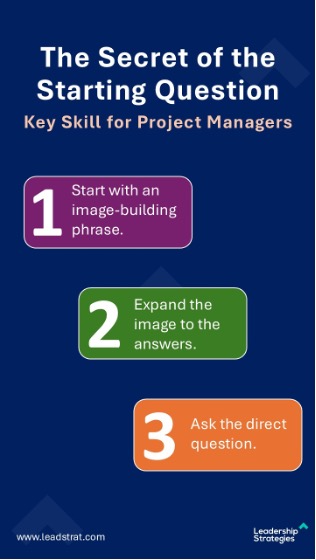What to Do When Your Question Gets Met With Silence
Questions are one of the most important tools project managers have to increase engagement and interaction in project sessions.
Yet, the most important question, the starting question, is a tool that few project managers have truly mastered. If you have ever been in the room when a project manager has asked a question that got no responses, you know what I mean. The complete and utter silence can be deafening and uncomfortable.
 But there is a secret to phrasing starting questions that nearly guarantees that you will receive a bonfire of responses every time. As an example: let’s say the project manager of a team working on improving the hiring process wants to build a list of problems with the current process. Which is the better question?
But there is a secret to phrasing starting questions that nearly guarantees that you will receive a bonfire of responses every time. As an example: let’s say the project manager of a team working on improving the hiring process wants to build a list of problems with the current process. Which is the better question?
TYPE-A QUESTION
What problems exist with the way we hire people today?
TYPE-B QUESTION
Think about the last time you hired someone. Think about the problems that occurred, the things that frustrated you about the process. The things that made you think, “We have got to fix this.” What are the problems with the current hiring process?
Most people say that the Type-B question is better. So why is it better?
The key is that the Type-B question allows your listeners to immediately begin visualizing their answers. Once they see their answers, they want to tell you what they saw, and their hands go up, immediately.
On the other hand, when a project manager asks a Type-A question, instead of creating an image for their listeners, they just ask what they want to know: “What problems exist with the way we hire people today.” This forces the participants to think about the question (not their answers) and try to create images on their own. What is the result? Silence…because the group is trying to create images that you didn’t create for them!
When you ask a Type-B question, they see their answers and respond immediately. So, how do you ask a great Type-B starting questioning?
Step 1: Start with an image-building phrase: “Think about the last time you hired someone.”
The image-building phrase puts participants in the scenario and gets them ready to see the answers. image-building phrases begin with such words as: “Think about”, “Imagine”, “If”, “Consider.”
Step 2: Extend the image to the answers with two or three additional phrases: “Think about the problems that occurred, the things that frustrated you about the process. The things that made you think, ‘We have got to fix this.’”
By extending the image, you give the participants the time and the images needed to see their answers.
Step 3: Ask the direct question: “What are the problems with the current hiring process?”
Like the Secret of the Starting Question? Download our free eBook on the 10 Principles of Facilitation that includes information on this tip and many others.
Looking to master facilitation techniques beyond the Starting Question? Level up with the Effective Facilitator course—an interactive, practical training packed with over 100 proven group techniques, including advanced questioning strategies that ignite discussion and drive engagement.
This course goes far beyond theory: spend 80% of your time practicing real facilitation skills such as consensus building, handling difficult participants, and energizing every meeting. You’ll get dynamic instruction, hands-on exercises, and continued support, including monthly refreshers and detailed agendas to transform every session you lead.
Take the next step: Enroll in the Effective Facilitator and discover how to ask questions that get participants talking, build buy-in, and deliver results—making every meeting a success.


About the Author
Michael Wilkinson is the trailblazing Founder of Leadership Strategies, renowned as the foremost provider of professional facilitators and facilitation training in the US. As a Certified Master Facilitator and a Certified Professional Facilitator, Michael’s expertise is in high demand as a trainer, facilitator, and keynote speaker. With a track record of leadership in the facilitation industry, including roles as past president of the Southeast Association of Facilitators, creator of the FindaFacilitator.com database, and founding board member of the International Institute of Facilitation, Michael is a leader in the industry. Dive deeper into his wealth of knowledge through his acclaimed books, including The Executive Guide to Facilitating Strategy, The Secrets of Facilitation, The Secrets to Masterful Meetings, and CLICK: The Virtual Meetings Book.

